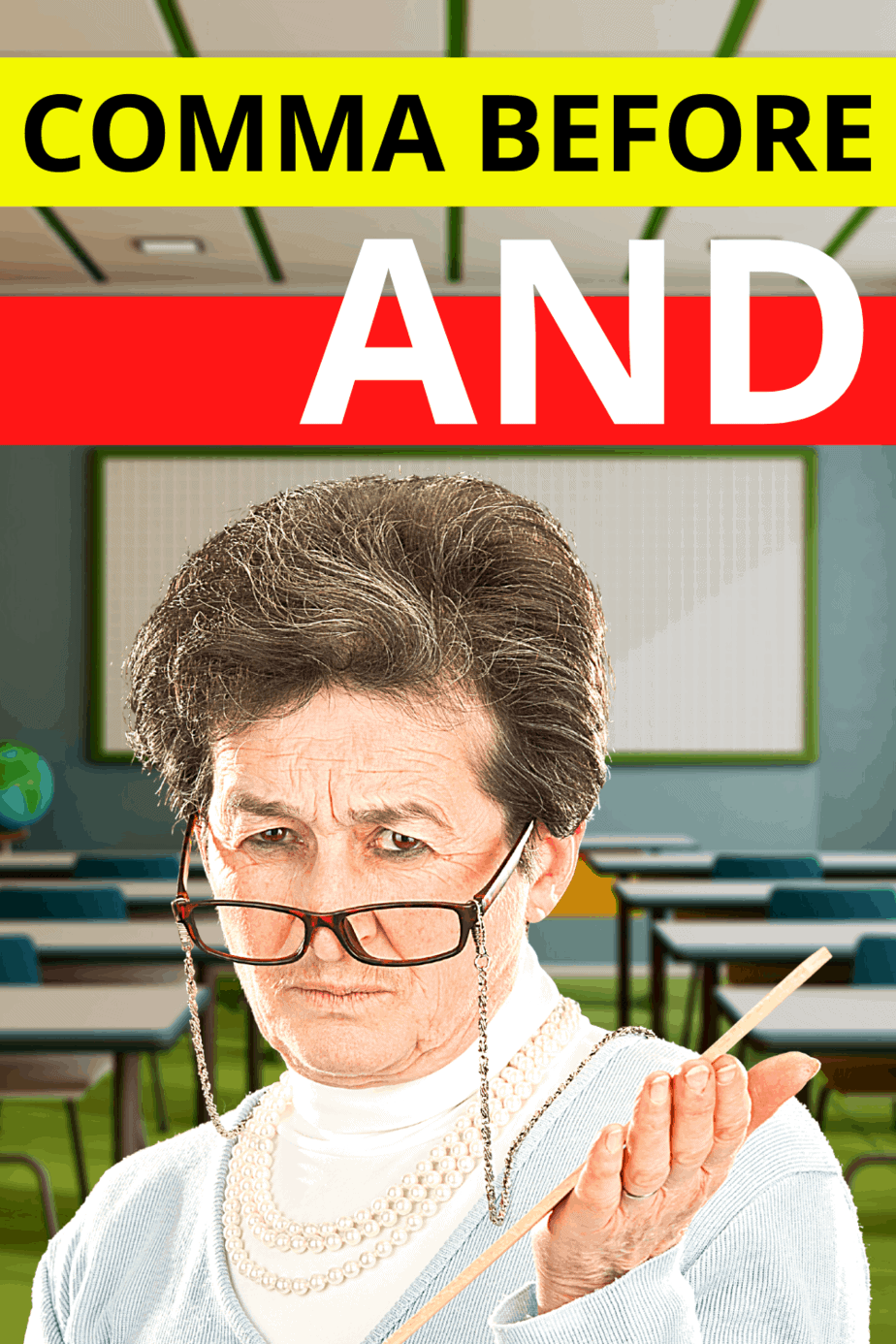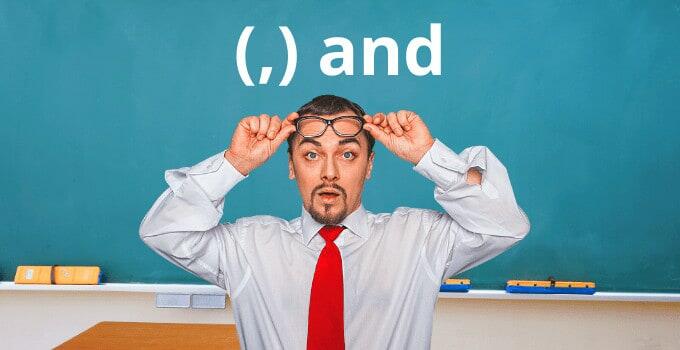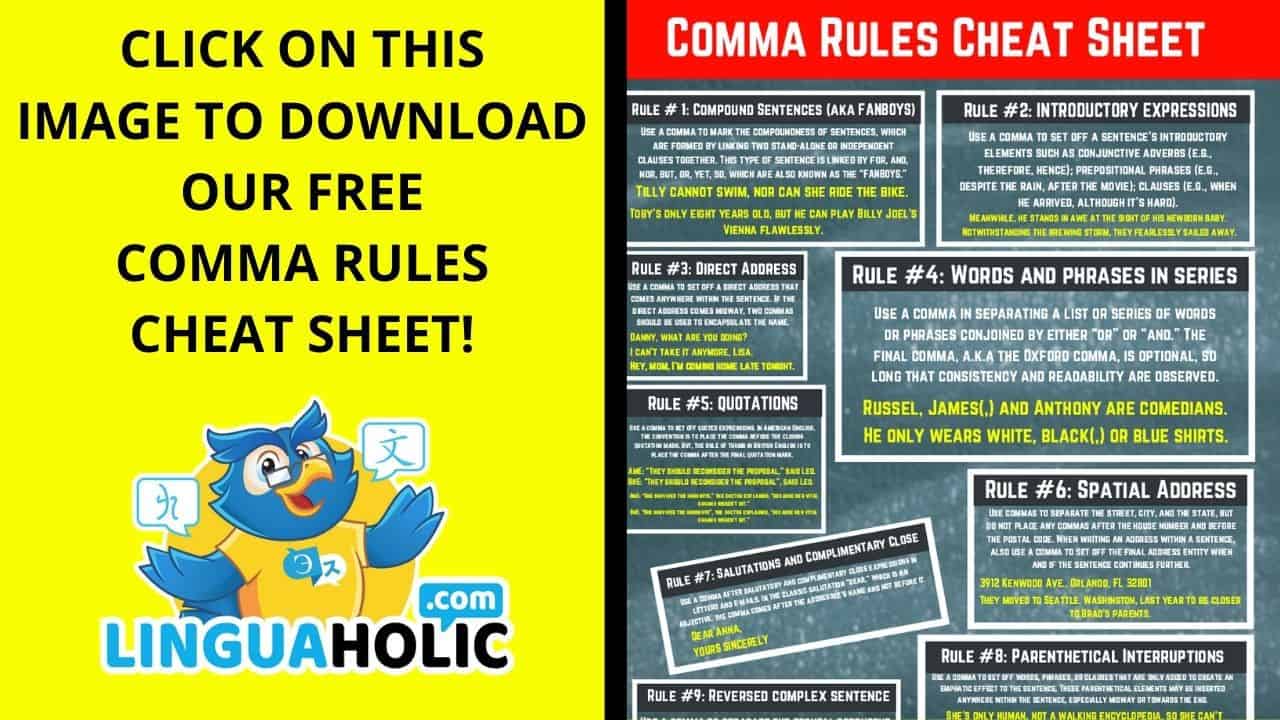Despite popular belief, the rules for using commas in a sentence don’t depend on what comes before or after a specific word.
Another common misconception is that you need a comma any time you would pause when speaking.
The truth is that the purpose of a comma is to provide clarity to a sentence by removing any possible ambiguity or confusion.
In other words, to figure out the correct way to use a comma with a specific word, you need to understand what that word is doing in a sentence and why.
With most words, this means learning comma rules is a simple matter of learning one or two parts of speech and how they might be used in a sentence.
Some words, though, are complicated, and can use commas in many different ways.
Some words, like “and,” fall somewhere in the middle. In this article, we’ll take a comprehensive look at using commas before the word “and.”
[toc]
When to use a comma before “and”
There is only one situation where you always need a comma before “and.” Any time you use “and” to connect two independent clauses (parts of a sentence that stand alone as a complete unit), you must use a comma before it.
In nearly any other use of “and,” you don’t need to add a comma, and in fact it’s often ungrammatical to do so.
Places when you should not use a comma before “and” are when it connects two individual words, when it connects two phrases (groups of words that do not stand alone) and when it is part of a list or series.
There are two possible times that the use of a comma is either optional or dependent upon your style guide. When “and” connects the last two items in a list, some style guides require what is called a serial (or Oxford) comma.
Other style guides, such as AP Style, require you not to use a comma in this case, however.
Finally, when joining two very short sentences or independent clauses with “and,” the comma is optional. That’s because the meaning is clear even without the comma.
About the word “and”
The word “and” is used to connect two clauses, phrases or words in a way that shows both are joined in some way.
You’ll see this word anywhere and everywhere, connecting everything from single words to whole sentences to one another.
One of the most common questions about the word is whether you need to use a comma before “and.”
At first, the answer seems impossibly complex. There are so many different places “and” can show up in a sentence, memorizing all the combinations is too difficult.
However, once you understand how the word is being used in a sentence it’s easy to figure out if a comma is necessary or not. No memorization is required!
Let’s take a deep dive into comma rules and the word “and.”
How coordinating conjunctions work
Technically speaking, the word “and” is a coordinating conjunction, used to connect two parts of a sentence.
That is, “and” can be used to connect anything from a pair of individual words to a phrase or loose group of words, to two complete sentences.
Importantly for comma use, coordinating conjunctions are also used to connect two independent clauses or a dependent and independent clause.
Clauses are groups of words containing at least a subject and a verb and, optionally, an object or other argument.
In plain English, a clause has to contain an action word (the verb) and the person or thing doing the action (the subject).
The optional part of the sentence is what’s being affected by the action word (the object).
As for independent and dependent clauses, the difference has to do with whether each clause can stand alone.
If the clause makes sense by itself, it’s an independent clause. If you need the other clause in the sentence for it to make sense, you’re looking at a dependent clause.
When “and” is used as a coordinating conjunction, it simply means that both parts of the sentence it connects are understood to be joined to one another.
For example, a bar serving “beer and wine” means that both are available.
Other examples of coordinating conjunctions are “but,” “or” and “so.”
To recap briefly before we look at commas before “and,” coordinating conjunctions are just words that show the relationship between two parts of a sentence.
Using a comma before “and” when connecting two independent clauses
If you’re feeling unsettled by all that grammar, take heart!
The fact is, there’s really only one place where a comma is required before “and.”
When is that? It’s when you’re using “and” to connect two independent clauses to one another.
Remember, independent clauses are clauses that stand alone. A good rule of thumb is that if you can split the clause off into its own sentence and still have it make sense, it’s an independent clause.
This rule also helps with when to use a comma before “and.”
If you have a sentence with “and” in it, simply remove the word “and” and pretend the parts of the sentence on either side are their own sentence.
Do both the new sentences make sense?
If they do, you’re dealing with two independent clauses and you definitely need a comma before “and.”
It’s as simple as that!
Examples
This is a clear case of two independent clauses or two clauses that can stand alone. To prove that, let’s break them out into individual sentences:
It’s pretty obvious that both new sentences make sense. That means we need to put a comma before “and” in this example sentence.
By the same rule as before, the “and” in this sentence is connecting two independent clauses.
The second clause, “It was a terrifying video,” is pretty short, but that by itself doesn’t mean it’s a dependent clause.
Since this is still an independent clause, you need to insert a comma between it and the other, longer clause when you’re joining them with “and.”
In both these cases, the comma helps readers understand the sentence easily. Like all commas, it’s there to add clarity.
Joining dependent clauses: no comma required
An independent clause, described above, is a clause that stands alone.
A dependent clause, on the other hand, is a clause that requires another, main clause in order to be understood.
You can use the same trick as above to identify dependent clauses. Simply remove it from the sentence and see if it makes sense.
If it doesn’t make sense, it’s a dependent clause and you shouldn’t use a comma to join it to the main clause.
Fortunately, you can only use “and” to join independent clauses.
That means you don’t need to worry about dependent clauses when figuring out if you need a comma before “and.”
All the same, it’s useful to know that for other coordinating conjunctions, there are some cases when you shouldn’t use a comma before them even when they’re connecting two clauses.

Comma rules for other uses of “and”
But I digress. The bare minimum you need to know for using a comma before “and” is just as described above.
What about other places when you can use “and”?
The word is a simple one, but it has a lot of places it can appear in a sentence.
If the trick above doesn’t satisfy you, read on to find out more about these other uses of “and.”
The very short version, though, is that no other use of “and” absolutely requires a comma, and in almost all cases they’re ungrammatical.
Do you need a comma when connecting two phrases with “and”?
Unlike a clause, which stands alone as a grammatical unit, a phrase is a group of words that doesn’t include a subject and a verb.
“Head of cabbage?” That’s a phrase. “Twelve purple turkeys” is also a phrase.
If you want to get technical, even “is also a phrase” is also a phrase.
Meta!
Seriously, though, phrases are just groups of words that couldn’t be turned into a sentence by themselves.
Do you need a comma before “and” if it’s connecting two phrases?
You do not. In fact, adding a comma will make your sentence ungrammatical here, so don’t do it!
Examples
Here, we have two phrases that are connected to form a pretty complex object for our verb “have.”
The first phrase is “ice cream” and the second phrase is “a bowl of chocolate chips.”
Both of these are joined by the word “and” to show that the person speaking wants both.
There isn’t a comma before “and” here because commas are only used when connecting independent clauses. Since these are phrases, don’t use a comma.
Again, there are two phrases here. This time, we have verb phrases, “play golf” and “go dancing.”
Even though the phrases are different parts of speech than before, they’re still phrases. That means we can’t put a comma before “and” here, either.
“And” to connect two words
In addition to phrases, “and” can connect two single words.
This is arguably the simplest use of “and,” and it’s certainly the one with the fewest words involved.
Just like with phrases, though, the comma rules are the same.
Don’t use a comma before “and” if it’s not connecting two independent clauses.
It goes without saying that a single word can’t be a clause, let alone an independent clause. That means if “and” connects two single words, you can’t insert a comma in front of it.
Examples
Llamas and sheep are both single words in this sentence, so when we use “and” to show that the speaker likes both, we don’t use a comma to connect them.
If there were a comma, our brain would think “and sheep” was the start of another sentence, which would be disorienting.
For example: “I like llamas, and sheep don’t.” Here, “and” is connecting two independent clauses, and the meaning of our sentence is totally different.
When it comes to single words, we can’t use a comma before “and.”
Using “and” in a list
In some rare cases, “and” can be used to connect more than two items in a list or series.
Technically, this isn’t really a separate use of “and.” After all, the items the word is connecting are going to be either phrases, single words, or clauses.
Because it’s really just another use of “and” in disguise, it probably isn’t a surprise that the comma rule is the same.
Unless all the items in the list are independent clauses, you should not put a comma before “and.”
Examples
In this classic line from The Wizard of Oz movie, the word “and” is forming a list.
Although it’s useful to know it’s a list, that doesn’t affect the comma rules.
None of our items in the list are independent clauses, so we can’t put a comma before any of them.
This might feel like a curve ball, since we’ve just said you shouldn’t put a comma before “and” in a list.
But let’s look more closely at this example. All the items in the list are actually independent clauses.
To prove that, you can split them out into three separate sentences: “I like lions. I like tigers. I like bears as well.”
Because we’re now joining independent clauses together, we do need a comma before “and.”
In short, the only thing we really need to consider is whether “and” is joining independent clauses.
If it is, you need a comma. Otherwise, you don’t.
Are there any times when using a comma before “and” is optional?
So far, this is all cut and dry. (Notice how “and” connects two single words there? No comma is used.)
Is it really that simple?
For the most part, yes, it is.
To be truthful, though, there are actually two times when using a comma is an option.
These two edge cases depend on what style guide you’re using, so be sure to check with a teacher or other authority if you’re using them somewhere that matters, like on a paper you want a good grade on or if you’re turning in an important report to your boss at work.
A comma conflict: “and” and the serial or Oxford comma
One of the most brutal conflicts in all grammar has got to be the serial comma, also called the Oxford comma.
As we know, one place you can use “and” is as part of a list.
In most style guides, that’s all there is to it. You follow the normal rules and still don’t put a comma before “and” unless it’s joining two independent clauses.
However, others argue that it’s essential to include a serial or Oxford comma.
In plain English, all that means is that these people think you need a comma before “and” when it’s in front of the last item in a list.
Otherwise, they say, all chaos breaks loose, and it’s impossible to tell the true meaning of a sentence.
There are some pretty good (and pretty funny) examples that prove the point, but the truth is that it’s almost always possible to tell what an author intended based on context or other clues.
For this reason, most style guides recommend that you don’t use a comma before “and” at the end of a list unless it’s otherwise impossible to understand the sentence properly.
The best thing to do here is to read the sentence aloud.
Does it make sense? Is it clear what all the items in the list are?
If the answer is no, you might want to add a comma before “and.”
Otherwise, unless your style guide absolutely requires a serial or Oxford comma, don’t add one in.
Examples
This is a classic example of why a comma can be useful before “and” in a series, and it’s often cited as an argument for the importance the serial comma. It’s probably apocryphal (that is, not a real thing anyone wrote), but it sure is funny.
What is the author saying here? Is he saying that his parents are the famous philosopher and author Ayn Rand and God, the all-powerful deity of Christianity?
Or is the author actually saying “thanks” three times? In that case, we might split this sentence up as: “I’d like to thank my parents. I’d like to thank Ayn Rand. I’d like to thank God.”
It’s pretty obvious that nobody in real life is going to think the author is literally God’s child, which is what makes this example so funny, but what if, instead, we had fewer clues to go on?
Is Mary the author’s mentor and the author’s wife in this sentence? Or are these three different people?
It’s completely impossible to tell without more context, so this is one time where you might want to use that serial comma to aid in clarity.
Although this sentence is a little ambiguous still (Is the phrase “my mentor” describing Mary, or are those two different people?) it’s definitely an improvement.
In other cases, though, things are immediately clear without a comma.
Nobody is going to think hiking and dancing are somehow the same thing in this sentence. That means you don’t really need the serial comma.
The bottom line is that unless your style guide requires a serial comma, or unless a sentence is completely unclear without it, you should skip the comma before “and.”
Very short sentences and “and”
The other case where comma aren’t completely necessary is when you have two very short independent clauses being joined by “and.”
Although you might technically need one based on the rule we’ve described earlier, it all goes back to clarity.
In a short enough sentence, it’s really obvious what the meaning of the clauses is and how they relate, so you don’t really need the comma.
Again, though, in formal settings it’s best to just put in the comma before “and” anyway.
Examples
Remember this example from earlier?
The two independent clauses are “I like llamas” and “sheep don’t.”
Technically a comma should be used to join them (“I like llamas, and sheep don’t.”), but it’s really obvious what this sentence means without the comma so it’s safe to leave it out.
Conclusion: the one simple rule for commas before “and”
This article has hit on a lot of points and used a lot of examples, so you might feel your head spinning.
Let’s finish up by reiterating the only rule you need to remember for comma use with the word “and.”
That rule is this: If “and” connects two independent clauses, use a comma before “and.” Otherwise, don’t.
That’s all there is to it!

Hey fellow Linguaholics! It’s me, Marcel. I am the proud owner of linguaholic.com. Languages have always been my passion and I have studied Linguistics, Computational Linguistics and Sinology at the University of Zurich. It is my utmost pleasure to share with all of you guys what I know about languages and linguistics in general.


